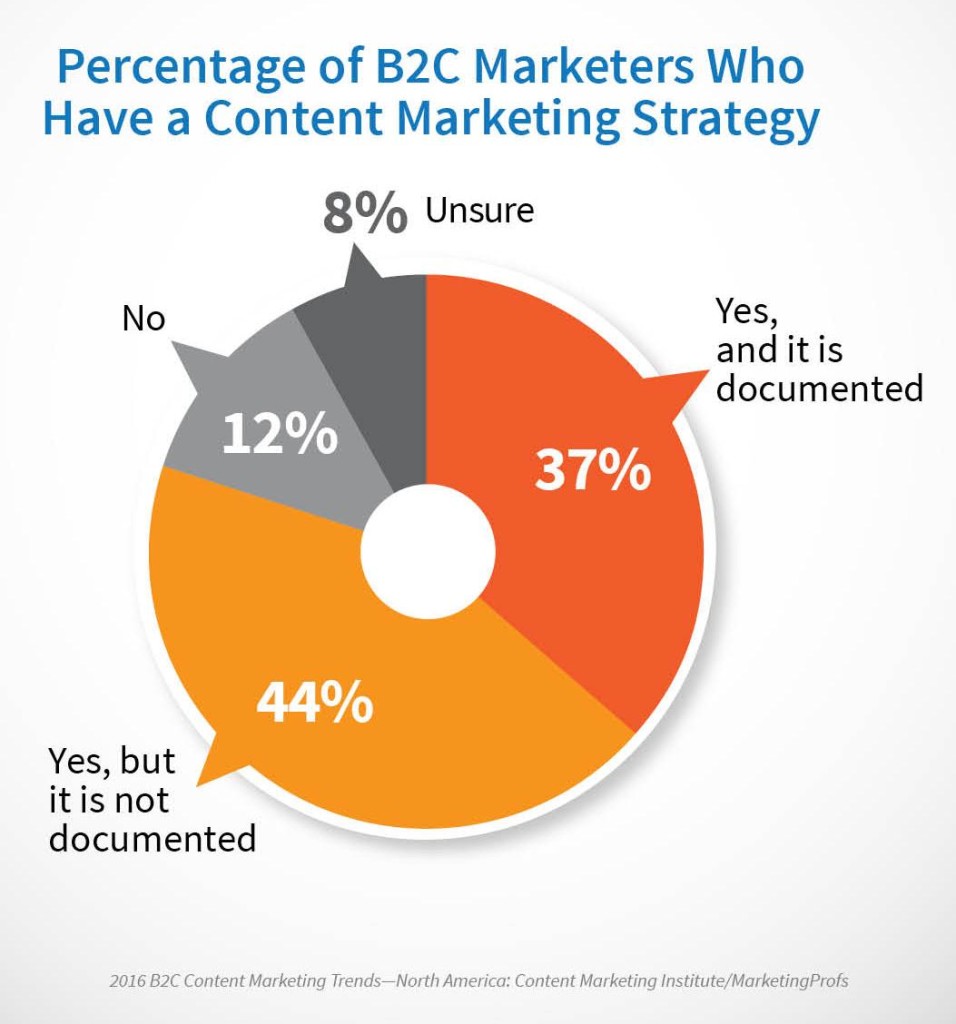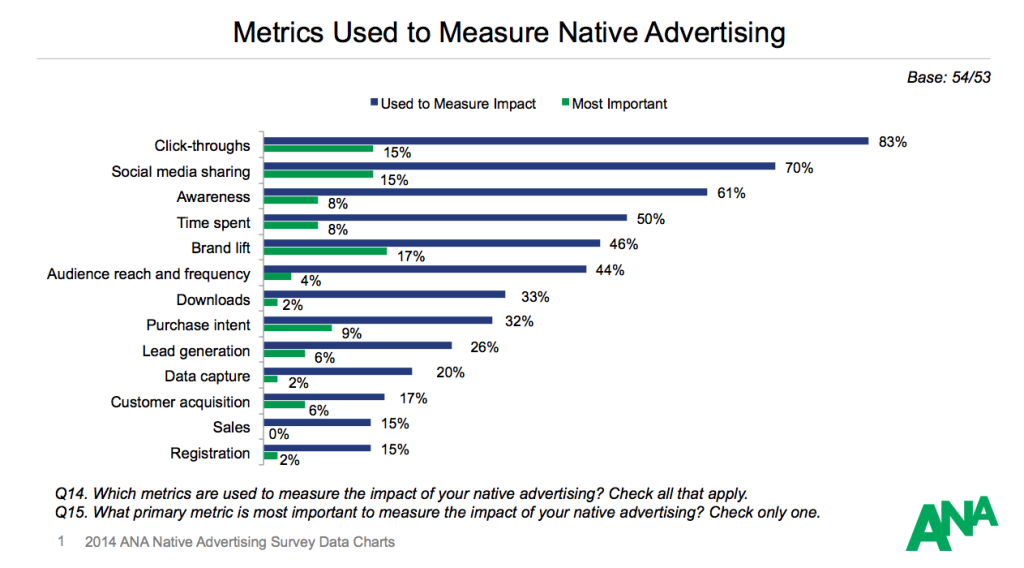Nothing matters to your marketing efforts quite like quality.
- With so many available online distractions, most site visitors will be put off by any imperfections in your content.
- On the other hand, though, high quality content can really make your business stand out, and can help you to develop a unique reputation and a strong voice of authority.
That said, creating high quality content takes planning and effort. With that in mind, have a look through this list of fifteen ways you can improve your content quality.
- The first few relate to performing solid planning and research – the backbone of your content creation strategy.
- The later suggestions on this list cover how to make the most of your content once you’ve decided on the best direction to take.
Be sure not to skip the planning stages, though: they’re the ones that often make or break a content marketing campaign!
1. Plan content around Business KPIs
One of the biggest problems that many online companies struggle with when creating marketing content is a failure to see the big picture.
- Your content needs to work towards driving up your key metrics, such as sales.
- It’s not enough simply to produce content and hope that it succeeds – you need to plan what you want content to accomplish.
Say, for example, your company’s set a goal of increasing website traffic.
Naturally, in this case, you’ll want to create content that draws more visitors to the site.
But more visitors who immediately leave, never to return, won’t help improve other metrics.
- Lots of traffic won’t translate into solid leads unless you’re appealing to the right groups.
- If your content isn’t preparing someone to make a sale, then no matter how pretty its visuals or how engaging its text, it won’t help you to grow your business.
A shocking 63% of marketers don’t have a documented content marketing strategy, which can mean losing out on a lot of opportunities.
- It also means that, by having a solid plan, you can gain a leg up on your competition.
The trick to success on this front is to plan ahead well in advance of beginning to produce content.
Before you begin creating any content at all, it’s important to first identify your business needs – that way your content can cater to what you need, rather than getting sidetracked or losing focus as the pressures of content creation increase.
2. Set Goals for Content Success
Once you know what you’re looking to achieve, it’s time to set specific goals for your content.
It’s easy to overlook this step, or to assume that setting goals won’t improve your content quality. But once the pressure to constantly churn out content begins, it’s a lot harder to keep things focused if you’re not working towards specific metrics.
You’ll want to decide in advance on:
- What your goals are for your company’s development and growth
- What you’re expecting to get out of your marketing efforts
Beyond this, decide exactly what you want your content to achieve? Typical examples include:
- A growth to your website traffic
- An increase in leads
- More sales
- Greater social media interactions and engagement.
Knowing what you want your content to do ahead of time means that if your content isn’t meeting your needs, you can clearly see where it’s falling down and can try new strategies.
While you might need to adjust your expectations once your content starts going online and you see the kind of reaction you’re getting from online communities, it really pays to have a clear grasp of the metrics that you want your content to improve.
3. Fully Research Market Demographics and Needs
It’s tempting, once you’ve set some goals and made initial plans (or possibly even before!), to just plow into content creation and start throwing stuff together.
After all, it’s only once you’ve got things made that you can start to feel productive!
One of the problems with this approach, though, is that it’s easy to make content that totally fails to connect with your target audience.
- Metrics like web traffic and lead generation can be misleading.
- Even if your content brings in lots of users, if they’re not the kind of people who’ll buy from you, they’re less than useless.
- It’s easy to get distracted by the wrong kinds of leads: people who like engaging with your content but who will never convert.
The most common metrics that content marketers rely on are click-throughs and social media shares, but these surface-level statistics don’t show how many site visitors are actually interested in your products.
For this reason, it’s important to take time to fully research who your customers are, and, most importantly, what they want.
- Once you’ve got an idea of the content that will appeal to your ideal clients, you’ll be able to make sure that your content appeals to the right people and draws in actual customers.
4. Choose Content Types Carefully
So hopefully, by now, you’ll know a little more about the kinds of customers you want to appeal to, and the kinds of benefits you’re hoping your content will provide.
Depending on these variables, your optimum content type might vary.
For example, say you’re marketing to millennials:
- 70% of Tumblr’s user-base is under 35, making it perfect for young people, but not great for retirees.
- More than 85% of millennials have a smartphone – if your content isn’t mobile friendly, you’re putting off your target audience.
- This means that you’ll want a content type that can be easily accessed on a smartphone, and easily shared on visual social media platforms.
This is just one example of how aiming content at a specific demographic and carefully choosing the type of content you produce can lead to greater opportunities to get your message in front of the right people.
5. Set a Regular Content Schedule
When it comes to content marketing, it’s important to have a solid, regular update schedule.
- A solid schedule lets you know how much work you need to perform on your content in a week.
- It also helps site visitors to know when something new is coming.
There are also peak times for content publishing to consider. For example:
- More people read blogs at the beginning of the day.
- Fewer people are on social media over weekends.
A good schedule lets you take advantage of these trends, as well as help you to make sure your content is of a high quality. Otherwise, it’s very easy to let quality slide while trying to pump out as much content as possible.
Keep in mind that companies that are posting content 3-4 times per week generate 5x more leads than companies who aren’t involved in content marketing.
That’s a big potential increase to your potential customer base, but to keep up with that that demand, your content quality will suffer hugely if you don’t have a regular, consistent routine to stick to.
Just remember: readers can always spot content that was thrown together at the last minute.
It pays to plan your content schedule long in advance, and to help you stick to it you may consider hiring writers externally.
6. Watch What Your Competition is Doing
In any type of marketing, it’s important to pay attention to the landscape around you.
With 50% of marketers planning to increase their content marketing spending in 2016, there’s never been a better time to see what other companies are up to, as well as to consider what might work for you.
- Competitors might see incoming trends before you, and it’s helpful to have a response to their work.
- Seeing the types of content that your competitors are producing also lets you know what type of content will look too generic, or won’t stand out compared to what other voices in your market are producing.
You never know where good ideas might come from, so take a broad approach to examining brand marketing, and take inspiration from any campaign you think will make your products look good.
7. Brainstorm Thoroughly to Create New and Original Ideas
Certainly, you want your content to be original.
- You want it to stand out.
- You want people to remember it.
- You want it to perfectly reflect your brand.
So, while it’s important to keep an eye on your competition (as I mentioned above), generic content that looks the same as everything produced by other players in your field is going to get completely drowned out.
For that reason, it’s important to come up with new ideas. You need to brainstorm.
So how can you make sure your brainstorming sessions produce excellent ideas?
- Basically, there’s strength in numbers – throw out as many ideas as you can. Write them all down. Once you’ve got all the obvious ideas out of the way, you’ll start coming up with the truly unique and memorable ones.
- Remember that no ideas are bad ideas – even something that sounds crazy just might work. Imagine the brainstorming session that invented the famous Old Spice ads! On paper, a commercial for a men’s body wash that’s aimed at women and features magical transforming diamonds sounds ridiculous, but you can’t argue with the effects!
8. Ask for Suggestions
If you’re working hard to produce solid, quality content, it’s easy to get lost in the excitement of what you’re doing and fail to spot problems.
For that reason, it can help a lot to ask for outside opinions from people who are less absorbed by your content. I’ve found that a fresh perspective can do wonders for making content that really stands out.
- You can get outsiders involved in the brainstorming sessions to offer up ideas that you’d never have even considered.
- Also, feel free to rely on outside opinions throughout the content creation process to make sure that your intended message comes across.
Invite fresh blood – ask for ideas and commentary from a variety of different sources.
It doesn’t matter if they’re not familiar with common marketing techniques or your company: suggestions they give might help plant the seed of a new idea that you can develop further.
In fact, the less they’re aware of your company, the better – you’ll be able to see your content through the eyes of someone who’s never come across your brand before, and that’ll help you to avoid taking anything for granted.
9. Use Facts and Data
(Pictured: everyone’s favorite Data set.)
Everything is better when you back it up with facts.
If you want your content to reach a high quality level, it needs to have a respectable level of authority.
Your content can’t just be based on opinion or hearsay – the more cold, hard, evidence-based facts you can produce, the better your content will be received.
- Site visitors will trust your content a lot more if it’s backed up by statistics or the results from studies.
- Other sites will link to your content to support their own arguments, as your content will be authoritative and informational.
The best data to use is facts and figures you’ve researched yourself. This can often be costly, though, so a helpful alternative is sourcing facts from elsewhere.
Citing studies and giving examples of proven facts from respected institutes show audiences that you’re not just making stuff up.
A few key facts can lend a strong voice of authority to your content and raise it to a higher level of quality.
10. Use Visuals Throughout
Holding people’s attention online can be difficult.
On average, the typical internet user looks at something for 8 seconds before getting bored and moving on.
What’s more, readers can only remember an average of 20% of a text that doesn’t contain images.
To grab people’s attention and make sure your content stays in their minds, it’s important to make your content as visually appealing as possible.
- Make use of images where possible which illustrate the point you want your content to make.
- Use a consistent brand color scheme to make sure that all of your content looks similar and that customers will recognize your work.
- Where possible, use visual content types, such as infographics and videos, to hook audiences and appeal to wider demographics who prefer to receive content in different forms.
By relying on a variety of different visual content types, you can make sure that your website visitors pause long enough to engage with your content, as well as to retain more information about your brand once they’ve finished reading.
11. Give it the Human Touch
Great quality content succeeds on many levels.
- It provides helpful, informative resources for those in need.
- It entertains and encourages engagement.
- It teaches site visitors about your brand and how your products can improve their lives.
In achieving these goals, it really helps if a brand is able to provide a human element. This can mean including:
- Real life stories about your products
- Examples from the world at large
- User experiences
- Recommendations from satisfied customers.
Telling stories is a great way to hook in readers – people love a good story and it can help to make a product seem real, or help site visitors to start thinking of how they’d make use of your products themselves.
Telling the story of your brand also can help users to identify with and develop loyalty towards your company, giving them all the more reason to become regular, dedicated customers.
12. Create Topical Content
While it’s important to have a solid publishing schedule that you stick to, it’s also important to be able to respond instantly to real world events.
- An event that’s relevant in the news is one that people are talking about, so it’s possible to ride the popularity of a topical subject to draw in crowds.
- What’s more, responding to current events gives you an opportunity to push your brand and produce unique content that you might not otherwise have imagined.
Some content can be prepared in advance, too, depending on upcoming news that’s bound to happen. Why not try something like the Coke ad which spoofed the Royal Wedding?
Or the Denny’s tweet that poked fun at the release of a new iPhone.
There will always be something new and current to reference in your content.
Just a warning, though: these references get stale fast, so it makes sense to keep them to content types that’ll be buried before long, not in white papers you’ll be relying on for years to come.
13. Make Use of Guest Creators and Collaborations
There are plenty of good reasons to involve guest creators an outside voices in your content:
- Additional viewpoints give your work more authority.
- Another creator will bring their own audience to your work.
- Different ideas can lead to new forms of content.
- You gain additional support in producing a high volume of content.
Guest creators can be of great benefit to your brand and its content – it can really pay off to involve another industry professional, or to make use of somebody who has more content development skills than you do.
- You can even interview special guests, creating solid and engaging content through a simple conversation with someone who knows that they’re talking about.
- It can also be useful to use quotes from other industry professionals to add authority to your content and lend greater strength to the argument you’re making.
There’s definitely strength in numbers, and getting more voices involved in your content (as long as they’re still on-brand) helps to build the authority and overall quality of work that you produce.
14. Keep it On-Point
There’s something to be said for brevity.
- Unnecessary waffling can ruin a good piece content.
- 79% of users scan content quickly rather than reading the whole text.
With that in mind, be sure to make your point without lots of filler content. Short and sweet is better than long and dull.
15. Use an Outside Editor
A depressing 52% of bloggers don’t rely on an editor, and it shows – I don’t know if you’ve noticed, but there’s a lot of poorly written content on the internet!
You don’t want your content to be full of punctuation errors or typos. While proofreading is essential to avoiding these pitfalls, it’s also helpful to employ the services of an outside editor.
Editors are important for fixing little mistakes in your work, and for helping to make sure the flow and style of the piece draw readers onwards.
Even if you’re not comfortable hiring a professional, it’s at least worthwhile getting someone else to read through your content and offer suggestions or point out mistakes.
Otherwise, after reading a piece over and over, you still might not be able to spot something that every single one of your site visitors picks up on immediately – and that can damage the perceived quality of your content, as well as hurt your company’s brand image.
Quality Matters
Using the tips, tricks and strategies on this list, you can dramatically increase the quality of the content that you produce.
- This will help lead more users to your site and create a greater buzz around your brand.
- It’ll help your content to stand out amid all the distractions that the internet holds.
- It’ll increase your authority and help you to develop a reputation as a brand that’s worth paying attention to.
- This will naturally lead to a greater presence in the marketplace, as well as more customers eager to sing your praises.
Quality really isn’t something that you can fake: it takes a lot of time and effort to produce content that people will really care about.
If you give your content the attention it deserves, though, you’ll see a fantastic boost to the success of all your marketing endeavors.
Good luck, and remember: genuine quality is what makes content marketing work.
What other strategies can you think of for boosting the quality of the content you create? Share your best tips and recommendations by leaving a comment below:
Images:
Flickr, Pixabay, Content Marketing Institute, Flickr, ANA, WebDAM, ProBlogger, Pixabay, Pixabay, YouTube, Pixabay, Flickr, Pixabay, Twitter, Twitter, Flickr, Pixabay, Pixabay

















